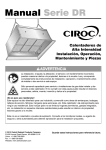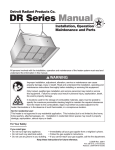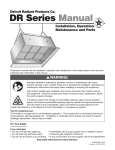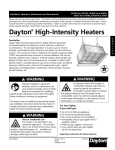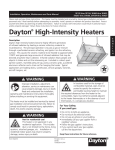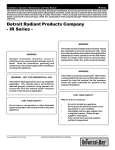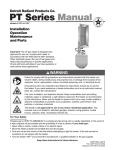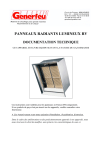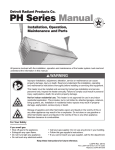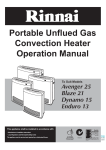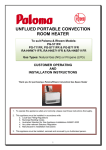Download Detroit Radiant Products DR 130 Specifications
Transcript
Detroit Radiant Products Co. DR Series Manual 0086 ! Gas Fired Radiant Plaque Heater Installation, Operation, Maintenance and Parts ! WARNING Read these instructions carefully before attempting to install, operate or service the heater. This heater must be installed and serviced by a Gas Safe Gas Engineer only! Conversion of the heater for use with other gases must be carried out by a Gas Safe Gas Engineer. All persons involved with the installation, operation and maintenance of the heater system must read and understand the information in this manual. Failure to comply with these warnings and instructions, or those on the heater, could result in personal injury, death, fire, asphyxiation and/or property damage. Not for domestic use! This unflued, gas fired, overhead radiant heater is designed for use in industrial and commercial building such as warehouses, manufacturing plants, aircraft hangars, service garages, etc. This heater is not approved in any domestic application. This includes (but is not limited to) the home, living quarters, attached garages, etc. Installation in domestic indoor spaces may result in property damage, asphyxiation, serious injury or death. The manufacturer cannot anticipate every use that may be made with their heaters. Check with your local fire safety authority if you have questions about local regulations. This appliance is pre-set for use in the country whose code appears on the appliance’s rating label only. If the code on the appliance does not match your application, refer to the technical instructions for adapting the appliance to the conditions for use in that country. © 2012 Detroit Radiant Products Company 21400 Hoover Road Warren, MI 48089 U.S.A. Voice: +1-586-756-0950 Fax: +1-586-756-2626 Website: www.detroitradiant.com Keep these instructions for future reference. LIOGDR-Rev. 12412 Print: 1M-8/12_r1-12/17/12(CDS) Replaces: LIOGDR-1M-5/12(CDS) DR Series Contents 1.0 Safety . . . . . . . . . . . . . . . . . . . . . . . . . . . . . . . . . . . . . . . . . . . . . . . . . . . . . . . . . . . . . . . . . . . . 3 Codes and Regulations . . . . . . . . . . . . . . . . . . . . . . . . . . . . . . . . . . . . . . . . . . . . . . . . . 3 General Specifications . . . . . . . . . . . . . . . . . . . . . . . . . . . . . . . . . . . . . . . . . . . . . . . . . 3 Safety . . . . . . . . . . . . . . . . . . . . . . . . . . . . . . . . . . . . . . . . . . . . . . . . . . . . . . . . . . . . . . 4 Clearance to Combustibles . . . . . . . . . . . . . . . . . . . . . . . . . . . . . . . . . . . . . . . . . . . . . . 6 2.0 Installation . . . . . . . . . . . . . . . . . . . . . . . . . . . . . . . . . . . . . . . . . . . . . . . . . . . . . . . . . . . . . . . 8 Design . . . . . . . . . . . . . . . . . . . . . . . . . . . . . . . . . . . . . . . . . . . . . . . . . . . . . . . . . . . . . 8 Heater Mounting . . . . . . . . . . . . . . . . . . . . . . . . . . . . . . . . . . . . . . . . . . . . . . . . . . . . . . 9 Ventilation . . . . . . . . . . . . . . . . . . . . . . . . . . . . . . . . . . . . . . . . . . . . . . . . . . . . . . . . . . . 12 Gas Supply . . . . . . . . . . . . . . . . . . . . . . . . . . . . . . . . . . . . . . . . . . . . . . . . . . . . . . . . . . 13 Electrical . . . . . . . . . . . . . . . . . . . . . . . . . . . . . . . . . . . . . . . . . . . . . . . . . . . . . . . . . . . . . 14 3.0 Operation . . . . . . . . . . . . . . . . . . . . . . . . . . . . . . . . . . . . . . . . . . . . . . . . . . . . . . . . . . . . . . . . . 16 Pre-Commissioning . . . . . . . . . . . . . . . . . . . . . . . . . . . . . . . . . . . . . . . . . . . . . . . . . . . . 17 Commissioning . . . . . . . . . . . . . . . . . . . . . . . . . . . . . . . . . . . . . . . . . . . . . . . . . . . . . . . 17 4.0 Maintenance . . . . . . . . . . . . . . . . . . . . . . . . . . . . . . . . . . . . . . . . . . . . . . . . . . . . . . . . . . . . . . 18 Troubleshooting . . . . . . . . . . . . . . . . . . . . . . . . . . . . . . . . . . . . . . . . . . . . . . . . . . . . . . 18 Replacement Procedures . . . . . . . . . . . . . . . . . . . . . . . . . . . . . . . . . . . . . . . . . . . . . . . 19 Converting Gas Type . . . . . . . . . . . . . . . . . . . . . . . . . . . . . . . . . . . . . . . . . . . . . . . . . . . 21 5.0 Parts . . . . . . . . . . . . . . . . . . . . . . . . . . . . . . . . . . . . . . . . . . . . . . . . . . . . . . . . . . . . . . . . . . . . 24 Heater Components Parts List . . . . . . . . . . . . . . . . . . . . . . . . . . . . . . . . . . . . . . . . . . . 24 2 DR Series 1.0 Safety • Codes and Regulations • General Specifications 1.0 Safety Codes and Regulations Not withstanding their limited scope, this appliance should be installed in accordance with relevant provisions of the following regulations: UNITED KINGDOM: Gas safety (Installation and Use) Regulations 1984 and BS 6896:2005. Due account should be taken of any obligations arising from the Health and Safety at Work etc. Act 1974, the current Building Regulations, the current I.E.E. Regulations and other relevant codes of practice. IRELAND: I.S. 3212:1987, ICP 4, I.S. 327. Due account should be taken of any obligations arising from the current Building Regulations, the current I.E.E. Regulations and other relevant codes of practice. General Specifications Table 1.1 • DR Series General Specifications D.M.S. Nat (I2H ) D.M.S. LP (I3P) Nat (I2H ) LP (I3P) Gas Connection Size Burner Qty. Width (mm) Height (mm) Depth (mm) Weight (kg) Burner Pressure (mbar) 8.8 43 2.25 52 1.60 15 25 1/2” BSP 1 314 575 289 8.2 DR 50 14.6 45 2.10 53 1.50 15 25 1/2” BSP 2 479 575 289 12.2 DR 60 17.6 43 2.25 52 1.60 15 25 1/2” BSP 2 479 575 289 12.2 DR 80 23.5 45 2.10 53 1.50 15 25 1/2” BSP 3 645 575 289 16.3 DR 90 26.4 43 2.25 52 1.60 15 25 1/2” BSP 3 645 575 289 16.3 DR 100 29.3 42 2.35 51 1.65 15 25 1/2” BSP 3 645 575 289 16.3 DR 120 35.2 43 2.25 52 1.60 15 25 1/2” BSP 4 810 575 289 20.4 DR 130 38.1 42 2.35 51 1.65 15 25 1/2” BSP 4 810 575 289 20.4 DR 150 44.0 43 2.25 52 1.60 15 25 1/2” BSP 5 975 575 289 24.5 DR 160 46.9 42 2.35 51 1.65 15 25 1/2” BSP 5 975 575 289 24.5 Model No. Nominal Input (kW) DR 30 Injector Size (mm) 3 DR Series 1.0 Safety • Safety Symbols • Applications ! ! WARNING Improper installation, adjustment, alteration, service or maintenance can cause property damage, serious injury or death. Read and understand, the installation, operating and maintenance instructions thoroughly before installing or servicing this equipment. Only trained, qualified gas installation and service personnel may install or service this equipment. Safety Symbols Safety is the most important consideration during installation, operation and maintenance of the infrared heater. You will see the following symbols and signal words when there is a hazard related to safety or property damage. ! ! WARNING Warning indicates a potentially hazardous situation which, if not avoided, could result in death or injury. CAUTION Caution indicates a potentially hazardous situation which, if not avoided, could result in minor or moderate injury. NOTICE Notice indicates a potentially hazardous situation which, if not avoided, could result in property damage. Applications This is not an explosion proof heater. Consult your local fire service, insurance carrier and other authorities for approval of the proposed installation. Commercial / Industrial Infrared heaters are designed and certified for use in industrial and commercial buildings such as warehouses, manufacturing plants, aircraft !hangars and vehicle maintenance shops. For maximum safety, the building must be evaluated for potential hazards before installing the heater system. A critical safety factor to consider before installation is the clearance to combustibles. Residential This heater is NOT approved for use in any domestic application. This includes, but not limited to, attached garages, living quarters, solariums, etc. Consult the local fire service and/or insurance provider if unsure of your application. ! WARNING Not For Residential Use. Installation of an infrared heater system in residential indoor spaces, RV’s, mobile homes, etc. may result in property damage, asphyxiation, fire, serious injury or death. 4 DR Series 1.0 Safety • Safety Labels Safety Labels Safety warning labels must be maintained on the infrared heater. Illustrations of the safety labels, and their locations, are pictured below. Figure 1.1 • Safety Label Locations Bottom Panel UNVENTED GAS-FIRED RADIANT HEATER UNVENTED GAS-FIRED RADIANT HEATER INDOOR (Non-Residential) INSTALLATION ONLY. High - Intensity Infrared Heater Class IIIA Permanent Label MODEL NUMBER: COUNTRY: DR30-G20-230V IE HEATER TYPE: AMPS - STARTING: VERSION: 0.15 AMPS - RUNNING: 0.13 NOx CLASS: C1 kW AM 09/06 S 15 MBAR MAX. INLET PRESSURE: INDOOR (Non-Residential) INSTALLATION ONLY. High - Intensity Infrared Heater Class IIIA Permanent Label 0086 CATEGORY: 87BT06 I2H (G20) Gas 17 MBAR MIN. MOUNTING ANGLE: 20 DEGREES MAX. MOUNTING ANGLE: 35 DEGRESS MODEL NUMBER: COUNTRY: DR30-G20-230V IE GROSS INPUT: 8.8 0086 Serial No.: 10 01XXXX XXXXXX 0001 VOLTS AC: HEATER TYPE: AMPS - STARTING: VERSION: 230V ~ 50Hz DETROIT RADIANT PRODUCTS COMPANY 21400 HOOVER ROAD - WARREN, MI (586) 756-0950 www.drp-co.com 0.15 AMPS - RUNNING: 0.13 NOx CLASS: MP C1 SA 09/06 MAX. INLET PRESSURE: 4 CATEGORY: 87BT06 I2H (G20) Gas MIN. INLET PRESSURE FOR PURPOSE OF INPUT ADJUSTMENT: 17 MBAR MIN. MOUNTING ANGLE: BURNER OPERATING PRESSURE: 15 MBAR PIN: LE kW 20 MBAR DESIGN COMPLIES WITH: EC GAP JUNE 1990 (90/396/EEC) LOW VOLTAGE DIRECTIVE (92/42/EEC) EMC DIRECTIVE (89/336/EMC) 0001 MIN. INLET PRESSURE FOR PURPOSE OF INPUT ADJUSTMENT: BURNER OPERATING PRESSURE: 4 0001 PIN: E PL 8.8 VOLTS AC: 230V ~ 50Hz GROSS INPUT: 20 DEGREES MAX. MOUNTING ANGLE: 35 DEGRESS 20 MBAR DESIGN COMPLIES WITH: EC GAP JUNE 1990 (90/396/EEC) LOW VOLTAGE DIRECTIVE (92/42/EEC) EMC DIRECTIVE (89/336/EMC) Serial No.: 10 01XXXX XXXXXX 0001 DETROIT RADIANT PRODUCTS COMPANY 21400 HOOVER ROAD - WARREN, MI (586) 756-0950 www.drp-co.com Heater Data Badge F/N: LLDCL003 Clearance to Combustibles Label 5 DR Series 1.0 Safety • Clearance to Combustibles Clearance to Combustibles ! WARNING Improperly connected gas lines may result in serious injury or death, explosion, poisonous fumes, toxic gases, asphyxiation. Connect gas lines in accordance to national, state, provincial and local codes. Placement of explosive objects, flammable objects, liquids and vapors close to the heater may result in explosion, fire, property damage, serious injury or death. Do not store or use petrol or other inflammable vapors and liquids in the vicinity of this or any other appliances. Failure to comply with the published clearances to combustibles could result in personal injury, death and/or property damage. ! CAUTION Signs shall be posted specifying the maximum permissible stacking height in order to maintain clearances to combustibles. A critical safety factor to consider before installation is the clearances to combustibles. Clearance to combustibles is defined as the minimum distance you must have between the infrared surface, or reflector, and the combustible item. Considerations must also be made for moving objects around the infrared heater. IMPORTANT: Fire sprinkler heads must be located at an appropriate distance from the heater. This distance may exceed the published clearance to combustibles. Certain applications will require the use of high temperature sprinkler heads or relocation of the heaters. Potentially flammable substances, such as propylene glycol or other antifreeze solution, are not to be used in conjunction with this heater without careful consideration for and avoidance of all potential hazards. When installing the infrared heater system, the minimum clearances to combustibles must be maintained. These distances are shown in Table 1.2 and on the heater. If you are unsure of the potential hazards, consult your local inspector, fire insurance carrier or other qualified authorities on the installation of gas fired infrared heaters for approval of the proposed installation. 6 DR Series 1.0 Safety • Clearance to Combustibles Table 1.2 • Clearance to Combustibles in Millimeters (see Figure 1.2) Model No. Sides Back Top Below/Front DR 30 750 450 710 1850* DR 50 750 450 1030 1850* DR 60 810 450 1030 1850* DR 80 1200 760 1230 2510 DR 90 1200 760 1230 2510 DR 100 1200 760 1230 2510 DR 120 1200 760 1330 3080 DR 130 1200 760 1330 3080 DR 150 1300 810 1540 3380 DR 160 1300 810 1540 * This clearance is 2030 mm when the heater is fitted with a parabolic reflector. 3380 NOTE: If the heater is mounted beneath a non-combustible surface, a 610 mm minimum top clearance must be maintained from the top of the heater to prevent overheating the controls. In locations used for the storage of combustible materials, signs must be posted to specify the maximum permissible stacking height to maintain the required clearances from the heater to the combustibles. Signs must either be posted adjacent to the heater thermostats or in the absence of such thermostats, in a conspicuous location. Figure 1.2 • Clearance to Combustibles Back Manifold or Control End Top Side Side Front 20° - 35° Mount Heater Level - Side to Side - FRONT VIEW SIDE VIEW 7 Below DR Series 2.0 Installation • Design 2.0 Installation WARNING ! Read and understand the installation, operating and maintenance instructions thoroughly before installing or servicing this equipment. Only trained, qualified gas! installation and service personnel may install or service this equipment. ! CAUTION Before installation, check that the local distribution condition, the nature of gas and pressure and adjustment of the appliance are compatible. ! WARNING Improper suspension of the infrared heater may result in collapse and being crushed. Always suspend from a permanent part of the building structure that can support the total force and weight of the heater. Failure to maintain minimum clearance to combustibles may result in fire and/or explosion, property damage, serious injury or death. Always maintain minimum clearances and post signs or provided tags where needed. Signs should state the hazards for the particular application and be legible to the building occupants. Consult the factory or a factory representative for additional information on signage compliance. Design To ensure a safe, properly designed heating system, a layout should be developed for the correct placement of the infrared heater(s). Aside from safety factors such as clearance to combustibles (see Table 1.2 on page 7), you should take into consideration the environment (e.g., cold/drafty, average, protected), heat coverage (m3) needed, heater centers, the distance behind a person or work station(s), and exhaust path. Also, the effective infrared surface temperature of a person or object may be diminished with winds above 8 km/h. Wind barrier(s) may be required. Most importantly, clearance to combustibles must always be maintained! This installation manual, along with applicable relevant codes, address these issues. It is critical that you read, understand and follow all guidelines and instructions. Always inspect and evaluate the mounting conditions, space for exhaust, gas supply and wiring. 8 DR Series 2.0 Installation • Heater Mounting Heater Mounting Whenever possible, fit the heater at the recommended mounting height above floor level (see Table 2.1 below). When considering heater position, ensure that the required minimum clearances between the various heater surfaces and combustible materials are preserved (refer to Table 1.2 on page 7). Extended parabolic reflectors are available for all heater models. When these are fitted, the higher mounting heights given in Table 2.1 should be maintained. Table 2.1 • Recommended Mounting Heights and Distances Model No. 30° Angle Standard Reflector (mm) 30° Angle Parabolic Reflector (mm) DR 30 3800 4300 DR 50 4200 5500 DR 60 4500 6100* DR 80 5000 6400 DR 90 5500 7000 DR 100 6000 7600 DR 120 7000 8200 DR 130 7500 8500 DR 150 8000 9200 DR 160 8500 10000 * Clearance to combustibles is increased when using this accessory on this model (see Table 1.2 on page 7). NOTE: Fixing heights are measured from the centre of the heater face. Factory recommended mounting heights are listed as a guideline. If infrared heaters are mounted too low or too high, they may result in discomfort or lack of heat. It is recommended that mounting heights are observed in order to optimize comfort conditions. However, certain applications such as spot heating, freeze protection or very high ceilings may result in the heaters being mounted outside of the recommended mounting heights. Figure 2.1 • Heater Orientation FRONT VIEW SIDE VIEW Spark electrode must be in lower right corner. Mount 20˚ - 35˚ from horizontal Mount Heater Level - Side to Side 9 Manifold control box must located towards the lower end of the heater (towards the floor). DR Series 2.0 Installation • Heater Mounting • Preferred Mounting Methods Preferred Mounting Methods Heaters may be suspended from roof structures by various methods. Figure 2.2 below shows common methods to mount the heater. Some local regulations or application conditions, such as draughts that could cause the unit to swing, stipulate that if flexible gas connectors are used then the heater must be rigidly mounted. The heater must be level from side to side and between 20° and 35° from horizontal. The igniter, manifold and controls must be located on the lower end. THE HEATER FACE MUST NOT MAKE AN ANGLE OF LESS THAN 20° WITH HORIZONTAL. The flue outlet area of the heater must remain free of obstructions at all times. Gas pipework or electrical cables must never be used to lend mechanical support to the heater. Figure 2.2 • Common Mounting Methods Steel “C” clamp Path of Flue Products Rigid threaded rod Welded Steel Chain hanging set Path of Flue Products Closed “S” hook (typical) 20˚ - 35˚ 20˚ - 35˚ Control End Down Control End Down SIDE VIEW SIDE VIEW 10 DR Series 2.0 Installation • Heater Mounting • Optional Wall Bracket Set Mounting the Heater Using Optional Wall Bracket Set Wall brackets allow mounting angles between 20° and 35° to the horizontal, and heaters must not be installed on walls, or at angles outside of this range. 1 Place brackets in proposed heater position on the wall. Check that they are properly aligned and mark in hole positions for fixing screws (see Table 2.2 below). Drill holes, fit plugs and use screws to fix brackets in position. 2 Fix each bottom side of the heater to the bottom side of its respective wall bracket using the nuts and bolts provided. Connect top sides of the heater to bracket using S-hooks and chain. Table 2.2 • Wall Bracket Mounting Dimensions (not included with heater) X A 138 X X 138 X Model No. Dim. A (mm) Dim. B (mm) DR 30 125 200 DR 50 287 200 DR 60 287 200 DR 80 453 200 DR 90 453 200 DR 100 453 400 DR 120 615 400 DR 130 615 400 DR 150 695 400 DR 160 695 400 Dim. A: Distance between mounting brackets. Dim. B: Rear clearance to combustibles. 11 Securing Chain B 20˚ - 35˚ SIDE VIEW DR Series 2.0 Installation • Ventilation Ventilation ! WARNING Insufficient ventilation may result in health problems, carbon monoxide poisoning or death. Vent enclosed spaces and buildings according to local regulations. Improper venting may result in asphyxiation, fire, explosion, injury or death. The space to be heated must be ventilated to remove the products of combustion and to provide an adequate supply of fresh air. The minimum air volume requirement must comply with local codes and to the guidelines set forth in this manual. The flue outlet area of the heater must remain free of obstructions at all times. Gas pipework or electrical cables must never be used to lend mechanical support to the heater (see Figure 2.3). Figure 2.3 • Hot Flue Discharge Flue Outlet Area Important! Do not install gas piping or electrical wiring above the flue discharge area! Manifold/Control End Down 20˚ - 35˚ SIDE VIEW Ventilation requirements in accordance to BS EN 13410:2001 must be adhered to. A minimum air displacement of 3.7 m3 /h per kW of total rated heat input is required. Example: One DR 30 is rated at 8.79 kW. Ventilation Requirement = 8.79 x 37.5 m3 /h = 329.62 m3 /h Air displacement may be accomplished by either gravity or mechanical means. Mechanical exhausters are preferred and typically mounted at high points on the roof where stagnant air accumulates inside the building. For a flat roof, considerations of prevailing winds, high and low pressure areas, and distribution of air movement must be taken into consideration when locating exhausters. A balanced system is essential to avoid negative building pressure which causes excessive infiltration, unfavorable drafts and affects combustion efficiency. NOTE: When heated, materials high in hydrocarbons (solvents, paint thinner, mineral spirits, formaldehydes, etc.) can evaporate. This may result in odors or fumes being emitted into the environment. To correct this problem, clean the area and/or introduce additional ventilation. Heaters installed and serviced in accordance with the installation manual do not emit foul odors into the environment. 12 DR Series 2.0 Installation • Gas Supply Gas Supply ! WARNING Improperly connected gas lines may result in fire, explosion, poisonous fumes, toxic gases, asphyxiation or death. Connect gas lines in accordance with the regulations listed on page 3. This heater must be installed and serviced by trained gas installation and service technician only. All pipework must be supported and installed in accordance with the regulations listed on page 3 and provide the operating gas pressure for the appliance. • The gas outlet must be in the same room as the appliance and accessible. It may not be concealed within or run through any wall, floor or partition. • The gas supply to the heater must terminate with an isolation cock and a flexible connector. This will allow the heater to be disconnected for maintenance or repair. • Check that the main gas supply line is of proper diameter to supply the required fuel pressures. Pipes of a smaller size than the heater inlet gas connection must not be used. • If utilizing used pipe, verify that its condition is clean and comparable to a new pipe. Test all gas supply lines in accordance with local codes. • Test and confirm that inlet pressures are correct. Refer to the heater data plate and packaging to verify fuel type. • Install a sediment trap/drip leg for condensation which may occur at any point of the gas supply line. This will decrease the possibly of loose scale or dirt in the supply line entering the heater’s control system and causing a malfunction. • The final connection is made to the heater’s gas valve. The has an Rp 1/2 inch ISO 7 thread (1/2 inch B.S.P. Internal thread). A flexible metallic hose conforming to BS 6501-1:1991 must be used for this purpose. This must be kept clear of the flue product opening at the top of the heater. • Take care when making the final connection to the gas valve not to apply excessive force to the valve. The valve inlet may be held using a 40 mm spanner (wrench). The following information is valid for heaters supplied in the UK and Ireland using either natural gas or propane fuel. Information on converting heaters for use in other European countries is given on page 21. Table 2.3 • Burner Pressure Type of Gas Required Burner Pressure Minimum Inlet Pressure Maximum Inlet Pressure Natural (I2H) 15 mbar 17 mbar 50 mbar Liquefied Petroleum (I3P) 25 mbar 27 mbar 50 mbar NOTE: The gas pressure governor has been factory preset. 13 DR Series 2.0 Installation • Electrical • Control Wiring Electrical ! WARNING Electric Shock Field wiring to the heater must be earthed and comply with I.E.E. and local authority recommendations. A 230 Volt, 50Hz, single-phase supply is required Important! Proper earthing and polarity are essential for heaters with spark ignition controls. If the system is not properly earthed, it cannot determine the presence of a flame and will lockout and shut off. All wiring must comply with I.E.E. and local authority recommendations. The wires in the mains lead used on this appliance are colored in accordance with the following code: Green and Yellow: Earth Blue:Neutral Grey:Neutral Brown:Live Black:Live The method of connection to the electrical supply must facilitate complete isolation and should preferably be made via a fused double pole isolator having a contact separation of at least 3 mm in all poles and supplying the appliance only. An alternative connection may be made via a fused three-pin plug and an unswitched, shuttered socket both complying with the requirements of BS 1363. Ensure that live, neutral and earth are connected correctly as the flame detection circuit will not operate correctly if the polarity of the supply is reversed. 14 DR Series 2.0 Installation • Internal Wiring Diagrams Before field wiring this appliance - Check existing wiring; replace if necessary. NOTE: If any of the original wire supplied with the appliance must be replaced, it must be replaced with wiring material having a temperature rating of at least 105° C. Figure 2.4 • 230V Circuit Board Internal Wiring Diagram G/Y L1 L2 BR BL 230VAC DSI MODULE BR G/Y W IGNITION MODULE G/Y BL BL BK O GY PR BK BR G/Y ELECTRODE ASSEMBLY GAS VALVE 15 DR Series 3.0 Operation • Annual Maintenance 3.0 Operation Annual Maintenance ! WARNING Electric Shock - Disconnect power to heater before servicing! Do not touch the ignition or flame detection electrodes or any part of the ignition/flame detection circuit while power is connected to the heater. The parts carry high voltages at all times and will give an electric shock if touched. Do not operate unit if repairs are necessary. Do not operate unit showing any signs of burner malfunction. Call a professional for assistance. ! CAUTION Avoid Equipment Failure. Do not blow out heating elements with high pressure air. Annual maintenance is normally sufficient unless abnormal site conditions necessitate that such work be carried out at more frequent intervals (e.g. dusty environment, etc.). The procedure outlined below should be followed: 1 Turn OFF electrical isolating switch and gas cock. 2 Remove dirt and other deposits from all heater surfaces. Low pressure compressed air may be used to clean ceramic plaques and venturies. IMPORTANT: Air hose pressure must not exceed 200 kPa or 30 psi. Gently pass the air hose over the entire exposed area of the ceramic. A distance of 610 mm to 1220 mm from the unit is recommended. Blowing out the gasket material will permanently damage the rayhead. 3 If necessary, remove and clean injectors. 4 Check that: - All ceramic plaques are free from cracks or other damage. - The heater fixing arrangements are satisfactory. - The flue products outlet is free from obstructions. - The minimum clearances between various heater surfaces and combustible materials are preserved. 5 Re-commission heater as outlined on page 17. 6 Switch OFF the heater and close gas service cock if heaters are not to be used for an extended period. Periodically inspect the gas supply for signs of corrosion or failure. Replace if necessary. 16 DR Series 3.0 Operation • Commissioning Pre-Commissioning Check Inspect ceramic plaques to ensure that none have been damaged. If any cracks are detected, the heater must not be commissioned until the affected burner unit has been replaced (See Section 4.0 Maintenance). Commissioning 1Ensure that the service cock to heater is turned OFF. 2Purge air from gas supply and test for gas soundness in accordance with the relevant Standards (see page 3). 3Check that all electrical connections are made to the heater and that the unit has a sound earth connection. 4Remove operating pressure test point screw (located on outlet of the gas valve) and connect pressure gauge. 5Remove inlet pressure test point screw (located on inlet of the gas valve) and connect pressure gauge. Figure 3.1 • Pressure Gauge Connections Figure 3.2 • Regulating Screw Set Point Connect pressure gauge here to check heater operating pressure. Connect pressure gauge here to check inlet gas pressure. 6Verify that the regulating screw set point is set to the 270° position as shown in Figure 3.2. 7Open the gas service cock. 8Switch on the power to the heater via remote electrical switch. After a purge period lasting a few seconds, the solenoid valves will open and the heater will come into operation having been lit by the electrical spark. 9Check heater operating gas pressure. This should be in accordance to the pressures listed on page 13 (Table 2.3). The pressure governor on the gas valve has been factory pre-set to the correct operating pressure. If the correct operating pressure is not measured, then it may be necessary to re-adjust this. Please see page 23 for details on how this is done. When the correct pressure is measured, switch off the heater. Remove pressure gauges. Replace and ensure test screws are tight and leak tested. 10 Test supply between service cock and heater for gas soundness. 11 If applicable, fit or post advisory/caution plate. The heater is now ready for use. 17 DR Series 4.0 Maintenance • Troubleshooting 4.0 Maintenance Troubleshooting Table 4.1 • General Troubleshooting Symptom Remedy Power is connected to the heater but nothing happens. Check electrical supply and all electrical connections. If this reveals nothing, it is likely that the ignition control has failed. Replace control. The electrode sparks but the heater fails to ignite. Check the heater inlet gas pressure (test point on gas valve). This should be at least 17 mbar for natural gas or 27 mbar for propane. Check electrode spacing (recommended gap=3 mm). Check operation of gas valve. Replace if necessary. Replace ignition control if the valve is not defective. The heater ignites satisfactorily, but switches off after a short period. Check electrode spacing (recommended gap = 3 mm and a 3 mm clearance should be maintained to the surface of the ceramic plaques). If this doesn’t resolve the problem, replace ignition control. A burner does not reach its normal operating This indicates that the burner has flashed back. temperature (orange color) and a loud roaring noise is This condition is caused by damage to the ceramic audible. plaques. Replace the affected burner assembly. 18 DR Series 4.0 Maintenance • Replacement Procedures Replacement Procedures Figure 4.1 • Replacement of Gas Controller Edge Connector Gas Controller 1Switch OFF electrical supply. 2Unscrew the screw which retains the cover of the control enclosure. Remove cover. 3Disconnect the spark electrode lead from the control box terminal. 4Unscrew the two machine screws which retain the gas controller in place. Disconnect the edge connector from the controller. Lift controller clear. 5Replace controller and re-assemble. 6Re-commission heater. Figure 4.2 • Replacement of Gas Valve Gas Valve Plug Union 1Switch OFF electrical and gas supplies. 2Disconnect gas valve plug from gas valve. 3Disconnect flexible connector from gas valve. 4Open the “union” which connects gas train to heater manifold. 5Replace gas valve and re-commission heater. 19 DR Series 4.0 Maintenance • Replacement Procedures Figure 4.3 • Replacement of Electrode Set If electrodes are damaged, they must be replaced complete with holder. Retaining Screws Proper installation results in 3.2 mm clearance from face of ceramic Electrode Set Set gap to 3.00 mm - 4.75 mm Side View 1Switch OFF electrical supply and gas service cock. 2Disconnect leads from electrodes. 3Remove electrode set from mounting bracket by unfastening the retaining screws. 4Replace with new electrode set. 5Re-assemble and re-commission the heater. Figure 4.4 • Replacement of Burner Assembly If the ceramic plaques are damaged, it is necessary to replace the entire burner assembly. M6 Screw and Nut Burner Flash Shield Flash Shield Screws 1Remove screws which retain the flash shield to the burner(s). 2Remove the flash shield. 3Remove the four 6 mm nuts and bolts which retain the burner unit to the heater frame. 4Remove burner and replace. 5Replace the flash shield. 6Re-commission the heater. 20 DR Series 4.0 Maintenance • Converting Heaters Converting Heaters from one Gas to Another Table 4.2 • Suitable Conversions Gas Supply Marking Gas Type Pressure Country of Use Notes Varies United Kingdom, Ireland, Austria, Denmark, Finland, Italy, Portugal, Spain, Sweden, Switzerland Suitable for use without modification. I2H Natural I3P LPG (Propane) 37 mbar United Kingdom, Ireland, France, Denmark, Portugal, Spain Suitable for use without modification. LPG (Propane) 50 mbar Austria, Germany, Netherlands, Spain Check operating pressure and reset to 25 mbar during heater commissioning. See page 17. LPG (Propane) 30 mbar Denmark, Finland, Netherlands, Sweden Check operating pressure and reset to 25 mbar during heater commissioning. See page 17. France, Belgium Convert heaters by changing gas valve with a valve which includes a flow restrictor instead of a governor. Convert Natural to I2E+ Convert Natural to I2ELL Varies 20 mbar These are physically identical to the I2H heaters, except that a change of injectors is required when the appliances are to be used on group LL gases (G25 @ 20 mbar). The operating gas pressure of the burner must be reset to 15 mbar after the injectors have been changed. Germany NOTE: DR-50 and the DR-80 models are not suitable for use with LL gases. Convert Natural to I2L 25 mbar Injectors must be changed to the sizes given in Table 3.3. Adjust operating pressure to 15 mbar after changing injectors. This must be done while the heater is supplied with Natural Gas at an inlet pressure of 25 mbar. Netherlands Table 4.3 • Injector Sizes Model No. DR 30 DR 50 DR 60 DR 80 DR 90 DR 100 DR 120 DR 130 DR 150 DR 160 Number of Injectors 1 2 2 3 3 3 4 4 5 5 Injector Size I2H, I2E+ and I2ELL Heaters (Nat Gas - G20) Injector Size I2L, and I2ELL Heaters Using group L and LL gases (Nat Gas - G25) Injector Size I3P Heaters (LPG - Propane - G31) (mm) Marking (mm) Marking (mm) Marking 2.25 2.15 2.25 2.15 2.25 2.35 2.25 2.35 2.35 2.35 43 44 43 44 43 42 43 42 42 42 2.50 2.35 2.50 2.35 2.50 2.60 2.50 2.60 2.45 2.60 40 42 40 42 40 38 40 38 41 38 1.65 1.55 1.65 1.55 1.65 1.65 1.65 1.65 1.65 1.65 52 53 52 53 52 52 53 52 52 52 21 4.0 Maintenance • Converting Heaters DR Series Converting a Heater from Natural Gas (I2H) to LPG (I3P) 1 If the heater is already installed, switch OFF the gas and electricity then remove the heater to the ground level. 2 Remove the gas injectors. 3 Replace the injectors with the correctly sized injectors for propane (see Table 4.3). 4 Re-install heater and connect electrical and gas supply. 5 Connect gas pressure gauge to operating pressure test point on the outlet of the gas valve (see commissioning on page 17). 6 Switch ON the heater. 7 Read the operating pressure from the pressure gauge. This must be adjusted to 25 mbar. 8 Remove the sealing ring on the governor adjusting screw. Turn the screw clockwise to increase the gas pressure to 25 mbar (see pressure adjustment on page 23). 9 When operating pressure has stabilized at 25 mbar, switch OFF the heater. 10 Remove pressure gauge and replace pressure test point screw. 11 Re-seal the governor adjusting screw using the sealing ring. 12 Replace or amend the heater data badge to show that the heater has been adjusted for LPG. Converting a Heater from LPG (I3P) to Natural Gas (I2H) 1 If the heater is already installed, switch OFF the gas and electricity then remove the heater to the ground level. 2 Remove the gas injectors. 3 Replace the injectors with the correctly sized injectors for natural gas (see Table 4.3). 4 Re-install heater and connect electrical and gas supply. 5 Connect gas pressure gauge to operating pressure test point on the outlet of the gas valve (see commissioning on page 17). 6 Switch ON the heater. 7 Read the operating pressure from the pressure gauge. This must be adjusted to 15 mbar. 8 Remove the sealing ring on the governor adjusting screw. Turn the screw counter-clockwise to reduce the gas pressure to 15 mbar. 9 When operating pressure has stabilized at 15 mbar, switch OFF the heater. 10 Remove pressure gauge and replace pressure test point screw. 11 Re-seal the governor adjusting screw using the sealing ring. 12 Replace or amend the heater data badge to show that the heater has been adjusted for natural gas. Converting a Heater for Operation on Nat. Gas (I2E+) in France or Belgium Follow the procedure outlined above for conversion of a heater for operation on natural gas. The gas valve on the heater (SIT valve model 0.840.061) must be replaced with a different valve (SIT valve model 0.830.010). This valve incorporates a gas flow adjuster instead of a governor. Follow the procedure outlined in Figure 4.2 - Replacement of Gas Valve; page 19. The operating pressure must be adjusted to 15 mbar as described above. Seal the flow rate adjuster screw using the sealing ring. Replace or amend the heater data badge to show that the heater has been adjusted. WARNING: The inlet gas pressure must not exceed 20 mbar for G20 or 25 mbar for heaters equipped with a flow adjuster. 22 DR Series 4.0 Maintenance • Converting Heaters • Adjusting Gas Pressure Converting a Heater for Operation on Group LL Nat. Gas (I2ELL) in Germany Follow the procedure outlined on page 22 for conversion of a heater for operation on natural gas. Replace the injectors with the correctly sized injectors for Group LL Natural Gas (see Table 4.3 on page 21). Adjust the operating pressure to 15 mbar using the procedure given on the previous page. Seal the flow rate adjuster screw using the sealing ring. Replace or amend the heater data badge to show that the heater has been adjusted. Converting a Heater for Operation on Natural Gas (I2L) in the Netherlands Follow the procedure outlined on page 22 for conversion of a heater for operation on natural gas. Replace the injectors with the correctly sized injectors for Group L Natural Gas (see Table 4.3 on page 21). With an inlet gas pressure of 25 mbar, adjust the operating pressure to 15 mbar using the procedure given on the previous page. Seal the flow rate adjuster screw using the sealing ring. Replace or amend the heater data badge to show that the heater has been adjusted. Adjusting the Gas Pressure The gas pressure is adjusted using the pressure adjusting screw on the SIT valve. On valve type 0.840.061 with governor, the screw is rotated clockwise to increase the pressure. The pressure adjusting screw is covered by a sealing ring. This must be removed prior to making any adjustments and replaced afterwards. Figure 4.5 • Gas Valve Pressure Adjusting Screw Gas Pressure Adjusting Screw 23 DR Series 5.0 Parts • Heater Components Parts List 5.0 Parts Table 5.1 • Heater Components Parts List Part Description Electrical Parts Reference List Stock No. Part Description Stock No. Electrode Set (3-prong) DR-230V Gas Valve - SIT 0.840.061 DR-230V Valve Cord 230V 3-Core Wire (560 mm) High Voltage Ignition Wire Low Voltage Ignition Wire 32-508 TP-740B DR-VC230 DR-3CW HVW-18 LVW-18 EN-298 CE Circuit Board Wire Harness for DR-230VCBA Red Rubber Spark Boot 230V Junction Box Bottom 230V Junction Box Cover DR-RH DR-RHP DR-LROD DR-SROD ORF#53 ORF#52 Injector 2.15 mm Injector 2.25 mm Injector 2.35 mm Injector 2.45 mm Injector 2.60 mm DR10-EMS DR-8STS DR-8SMS DR-20MB 1/4-20 Hex Nut (mates to DR-20STB) 1/4-20 x 1/2” Self-tap Bolt Union Fitting, 3-piece DR-MAN^ DR-UF^ DR-HS^ DR-FLSH^ DR-RFE^ DR-^REF Side Frame Electrode Mounting Bracket Side Frame Insert Embossed Reflector Sides Cross-over Bracket DR-CB230A DR-WH230A DR-RSB DR-PJBB DR-PJBT Burner Related Parts Reference List Rayhead with Center Support Rayhead no Center Support (DR 30 LP) Long Rayhead Rod Igniter Rayhead Rod Injector 1.55 mm Injector 1.65 mm ORF#44 ORF#43 ORF#42 ORF#41 ORF#38 Nuts & Bolts Reference List 1/4-10 Short Electrode Mounting Screw #8 x 1/2” Sheet Metal Self-tap Screw #8 x 1/2” Common Sheet Metal Screw 1/4 - 20 x 1/2” Machine Screw DR-20HN DR-20STB DR-MU Core Components Reference List Manifold (*specify 1-5) Upper Frame (*specify 1-5) Heat Shield (*specify 1-5) Flash Shield (*specify 1-5) Reflector End (*specify 1-5) Full Reflector Assembly (*specify 1-5) DR-SF DR-EMB DR-SFI DR-ERS DR-CO * (1=DR 30; 2=DR 50-60; 3=DR 80-100; 4=DR 120-130; 5=DR 150-160). ^ Specify model number. NOTE: Replacement burners are called “rayheads”. Ceramic plaques are not sold separately, order DR-RH. Figure 5.1 • Heater Assembly Components Cross-over Bracket Heat Shield Path of exhaust Rayhead Assembly with Ceramics Side Frame Brass Union Manifold Pressure Tap Manifold End Frame Assembly Rods Reflector Shield 32-508 Electrode Assembly Gas Orifice High Voltage Wire Low Voltage Wire Valve Cord Circuit Board (inside junction box) 24 Gas Valve
























